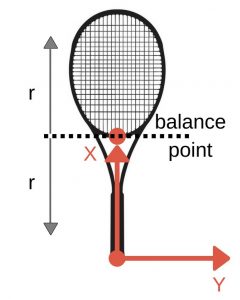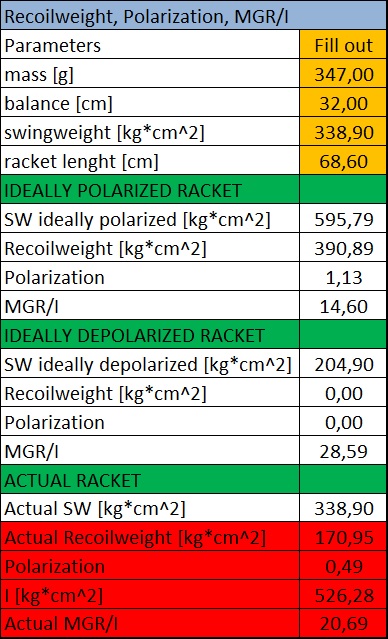Recoil weight is basically the swingweight or moment of inertia around the balance point of the racket. Let’s take a look at the racket axes on the picture below.

If we know the racket specifications, we can calculate the recoilweight by using the parallel axes theorem as shown in the equation (1).
\(RW=SW-m\left( x_{B}-10cm\right) ^{2}\)
(1)
It’s called recoilweight because it’s a measure of how stable the racket is during the contact – how much it recoils and how much of the recoil shock is transferred to the arm. Higher recoilweight means that the racket is more stable during contact. Low recoil weight is among the most common causes of arm pain and injury.
High recoil weight means that we have to have a lot of mass far away from the balance point, ideally on the opposite poles (tip of the racket and the handle). This is where term polarization comes in to play.
Polarization is a measure of how far away from the balance point the mass of the racket is distributed. As described in the equation (2) it’s just a ratio between recoilweight and the mass.
\(Po=\dfrac {RW}{m}\)
(2)
\(RW=Po\cdot m\)
(3)
We can see that in order to have a hight RW we need to have either a very polarized racket, or a very heavy racket.
Now let’s take a look at the polar opposites. An ideally polarized (left) and ideally depolarized (right) racket.

Both objects (rackets) have the same weight and balance point, but one has the mass equally distributed on the opposite ends and the other has the mass concentrated in the balance point. Using the equations from the previous chapters, we can calculate the swingweight and further determine recoilweight and polarization, as shown on the picture below. The calculation is performed for the actual racket and for the racket as if it was ideally polarized and depolarized.

We can see that ideally depolarized racket would have the Po=0 and ideally polarized around 1. There are calculations for MGR/I but more on that in the next chapter. Also, I share all these calculations sheets with my supporters.
If you are looking to modify and custom tailor your racket, check out our Products and Services.
You can also calculate recoilweight and polarization here: